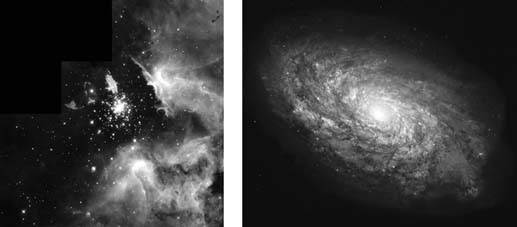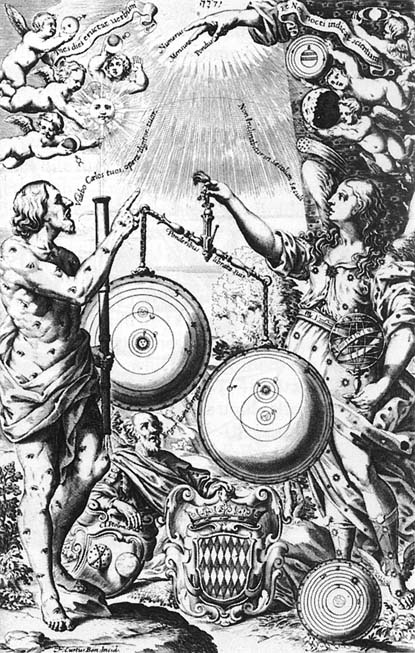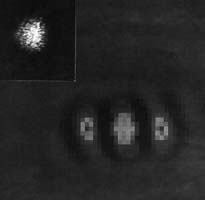
I'm sending you two newly-released Hubble Space Telescope (HST) pictures from the June 8 New York Times Science Times under the subheadings "Lives and Deaths of the Stars," and "A Dusty House of Stars" (online at http://oposite.stsci.edu/pubinfo). The first one captured various stages of the life cycle of stars in one single view! The second is a Key Project of HST on the Extragalactic Distance Scale.

Sometimes the words of sudden epiphanies can come out of us a little garbled and nonsensical, but nevertheless when I saw these "awe"-filled images, I blurted out, "Just look at these fantastic pictures -- they're pictures of us!" I say this with firm conviction because I take to heart the truth of the ages-old architectural adage -- "As above, so below" -- and couple it with the constructive and inspirational statement by 20th-century astronomer Harlow Shapley: "Mankind is made of starstuff, ruled by universal laws." Is it any wonder that Zen scholars can say with the same assurance, "The fire we are seeking is our own [galactic] lantern," or that the Dhammapada tells us: "Look within -- Thou art Buddha."
The striking beauty of these universal and Buddhistic statements about our celestial vault's "light fantastics" is that we humans house a quasi-copy of them right within our own breast-vault -- the whole cyclical show --from the rich and fertile stardust, to "proplyds" (star buds), to radiating solar blossoms and their planet-seeds of eternal return. Stardust is the clay of the mystical "firemist" -- the "concreted light" from which we are fashioned. So it is that we are a scaled-down Milky Way galaxy ourselves; we are the galactic "curds" or "crowds"; we are a supercluster of relativesized molecular galaxies that gravitate toward and encircle the "Great Attractor" of our inner or Divine Selves. I am sure that all mythical Supermen, and even modern scientists like Einstein, knew and used this wisdom to their advantage.
Now add this engraved frontispiece by 17th-century astronomer/theologian Father Riccioli from his Almagestum novum. On the right the winged figure Astraea is adorned with stars and represents Astronomy. Opposite and facing her is the mythological figure Argus of the hundred eyes; he represents the astronomer in search of divine Truth.

The Imagineer in me sees Argus as a natural interferometer -- an instrument designed to achieve high resolution of distant stars (and who knows, maybe even distant ideas) by connecting two or more telescopes (eyes) to operate as a single instrument, where incoming light (or thought-beam) is split and recombined to form interference waves or phenomena, recording data that can be computed and imaged. Interestingly, a hundred or so years after Riccioli, the English visionary poet Samuel Taylor Coleridge wrote in one of his notebooks: "He looked at his own Soul with a Telescope. What seemed all irregular [interference waves?], he saw and shewed to be beautiful Constellations [images?]; and he added to the Consciousness hidden worlds within worlds." Eureka! All the more circumstantial evidence that the celestial ocean of history has its star-transformed Men.
Lastly, it is known that Albert Einstein kept H. P. Blavatsky's The Secret Doctrine at his desk. I feel sure that his perusal of her 19th-century re-introduction of "cosmic" and "human" life gave him pause to sort out his epiphany when he intuitively concluded: "The cosmic religious feeling is a deep conviction of the rationality of the universe. It is the most important function of art and science to awaken this feeling."
"Awaken" indeed! With these evidences of adage, art, myth, etc., punctuated with profound Hubble Space Telescope images, we can begin to see, like Argus, a hundredfold through the many light-gathering eyes of our "interferometer" Selves. -- WYNN WOLFE
PS: I just came across this example of "speckle interferometry" from Kitt Peak Observatory: the image of a star is reconstructed after being broken up by passage of starlight through the earth's atmosphere.

The inset photo (upper left) of the double star system Capella shows many tiny individual images that constitute the large blurred object we normally see. A large number of very short exposures were taken, freezing the star in time as it twinkles. The final computer-processed image shows the brighter G5 giant star at the center, its G0 companion appearing twice, one on each side. One is real, and the other is a "ghost image."
Isn't this star-focusing process analogous to the human-focusing creative process? A bright concept or idea hovers in the celestial vault of our mind, at first appearing fuzzy. Then, through the "Argus" of ourselves, we are able to take a large number of short exposures, freezing our bright idea's light in time as it twinkles in and becomes the product of our creative effort. I say again, "Look at this fantastic picture -- it, too, is a picture of us!"
(From Sunrise magazine, August/September 1999; copyright © 1999 Theosophical University Press)